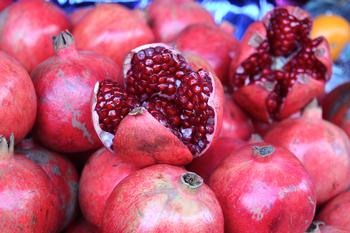Pomegranates
updated September 2020

The pomegranate is a native fruit of the Middle East. Its name in Latin means “apple with many seeds,” but it actually looks somewhat like a petrified tomato. The pomegranate plant can be used for its aesthetic beauty in hedges, as a shrub, a tree or for its fruit. The pomegranate plant is well adapted to the hot, dry climate of the Southwest and grows in a wide range of soils.
FRUIT USE
The edible portion of the fruit includes the seed and the juicy translucent flesh covering the seed. The tart flavor of the pulp and juice can add interest and variety to other foods. The flesh-covered seeds can be used as a garnish in fruit cups, compotes, salads, desserts, and as a snack. The juice is used to make jellies, puddings, desserts, and drinks. Grenadine, made from pomegranate juice, is a flavoring in some beverages. Grenadine is also a delicious topping for ice cream and chilled fruits such as peaches, pears, and bananas.
REMOVING THE SEEDS
It’s a good idea to wear an apron when handling pomegranates. They tend to spurt, and the deep red stain is difficult to remove. Because pomegranate juice can darken if it comes in contact with metal, use plastic or glass utensils. When you need a large number of seeds, cut off the crown and score the pomegranate lengthwise in three or four places. Seeds can also be removed by cutting the pomegranate in half, placing the cut face down, and rapping the shell firmly with a blunt instrument such as a hammer handle. The juice sacs are somewhat easier to remove. While holding the fruit under water, split the sections and separate the seeds from the section walls. The seeds will sink to the bottom and the peel and membranes will float. Skim off membranes and drain seeds in a colander.
EXTRACTING THE JUICE
One large pomegranate yields between one-fourth to one-half cup of juice. To get the juice, crush or press the seeds. Seeds can be pressed in a sieve or food mill. Juice can also be extracted by whirling seeds, 1 1/2 cups at a time, in a blender or food processor until liquefied, then straining them. Strain crushed pulp through a double thickness of cheesecloth or nylon netting to remove seeds. Another method of obtaining juice is to cut the fruit in half and use a juice press or juicer. Press, do not twist the fruit. The rind contains tannin, which gives the juice a bitter taste. Place the juicer in the sink to avoid splattering. Strain juice.
FREEZING
The juice can be frozen or canned. Freezing is recommended because juice will hold its flavor and color better. To freeze, fill freezer containers, leaving 1/2-inch headspace for expansion. Label with the date, then store in an upright position until the juice is frozen. Freeze the seeds for use in salads and appetizers by spreading them in a single layer on a cookie sheet. Quickly freeze, then transfer to and store in moisture, vapor-proof freezer bags or
containers. For other uses, pack seeds in containers and cover with cold, 30 percent syrup. Make the syrup by heating two cups of sugar in four cups of water until sugar is dissolved. Cool syrup, then pour over fruit. Leave 1/2 inch headspace, seal, and freeze.
CANNING
Pomegranate Juice
Canned juice may turn brown and lose its flavor. Adding two tablespoons of bottled lemon juice to each quart of juice helps retain color and flavor. Bring juice quickly to a boil, pour into hot jars, adjust lids, and process.
*Jars that will be processed for less than 10 minutes should be sterilized before filling. Sterilize by heating jars in boiling water for 10 minutes.
SYRUP AND JELLY
Grenadine Syrup
4 cups pomegranate juice
2 cups sugar
Combine juice with sugar and stir. Heat just to simmering and simmer three to five minutes. Cool. Store syrup in the refrigerator for one to two weeks or in the freezer. Use as topping for ice cream or chilled fruits or in beverages.
Pomegranate Jelly
3 1/2 cups pomegranate juice, fresh, frozen and thawed, or bottled
1/4 cup lemon juice
1 package (2 ounces) powdered pectin
4 1/2 cups sugar
Yield: 6 half-pint canning jars.
Combine pomegranate juice, lemon juice, and pectin in a 4- or 5-quart pot. Bring to a boil over medium-high heat, stirring constantly. Stir in sugar until well blended; return to a boil and continue boiling, uncovered, stirring occasionally for 2 minutes. Remove jelly from heat. Let stand a minute to allow foam to form; then carefully skim off the foam. Pour hot jelly quickly into hot half pint jars, filling jars to within about 1/4 inch of tops. Carefully wipe off rim of jar. Put lid on each jar as it is filled, screwing ring band on hand tight. Process in hot water bath for 10 minutes. Cool jars away from drafts on a towel. If jars do not seal, refrigerate. Label sealed jars and store in a cool, dark area.
STORAGE
Store pomegranates in a cool, dry well-ventilated place. The fruit should be spread on shelves or tables or hung by tying strings to the fruit stems. Fruit can also be refrigerated. Fresh seeds or juice will keep in the refrigerator for up to 5 days. Use frozen pomegranates within 1 year.
NUTRITIONAL VALUE
The pomegranate’s main food value is carbohydrates. Half a medium pomegranate is 82% water and about 50 calories. It is an excellent source of potassium (199 mg) and is very low in sodium (2 mg).
